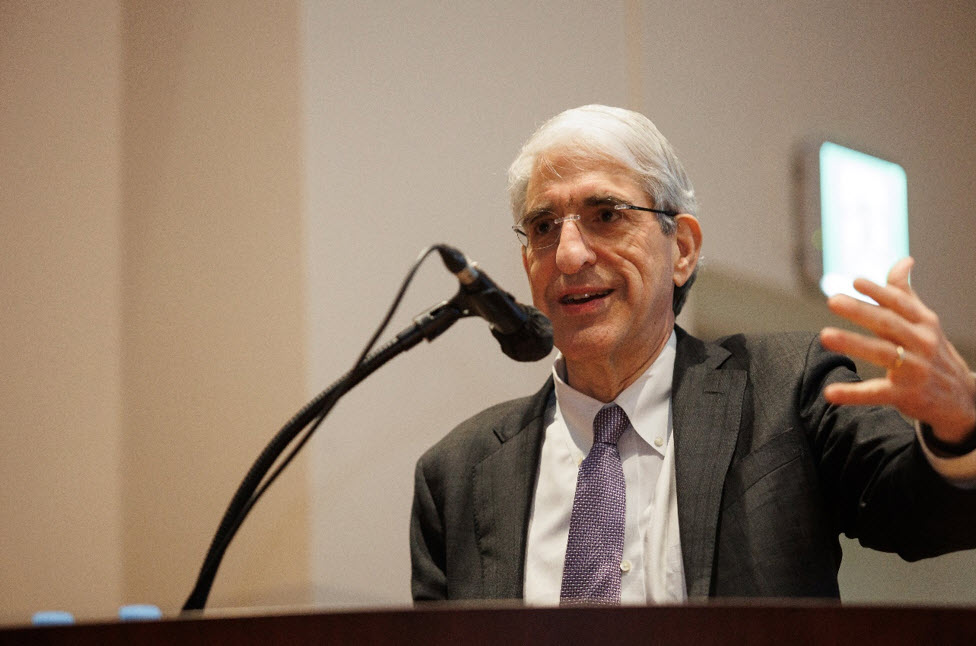Emotions are a regular part of our lives that determine how we feel or even act. Yet the academic study of emotional intelligence is a fairly recent development. Drawing on his research on emotional intelligence in diverse contexts such as Fortune 500 companies and K-12 classrooms, Yale University’s President Peter Salovey gave an insightful lecture on his study of emotions on March 24 at the SNU Cultural Center.

“Emotional Intelligence in the Lab, Workplace, and Classroom,” by President Peter Salovey of Yale University
President Salovey traces the study of emotions back to Darwin’s research on animals in the wild. As Darwin explained, emotions have helped animals survive in a number of ways. When faced with the threat of a predator, emotions such as anger and fear can help energize required behaviors that increase the likelihood of survival. Understanding and displaying emotions are other helpful skills that Darwin identified—for example, the knowledge to bare one’s teeth when defending territory, or to back off when met with a similarly aggressive response. Though Darwin’s observations might seem obvious, revisiting his ideas in the 1970s unlocked a whole new field of study in psychology that redefined our use of emotions as a functional skill comparable to intelligence.
Setting out to investigate this novel approach to emotions, President Salovey and his co-researcher Dr. John D. Mayer published a paper titled “Emotional Intelligence” in 1990. In it, they defined emotional intelligence as “the ability to monitor one’s own and other’s feelings, to discriminate among them, and to use this information to guide one’s thinking and action.” Initially the paper didn’t gain much traction, receiving little to no attention from the academic community, until five years later when psychologist Dan Goleman took notice of their ideas while working on a book of the same title. Goleman’s book Emotional Intelligenc was a huge success, gracing magazine covers from countries around the world. Though few had predicted that the study of emotional intelligence had much promise in academia, the book catapulted President Salovey’s research into the limelight of public discourse. With its increasing acceptance in psychology, President Salovey resolved to dive deeper into his research on emotional intelligence.
To begin with, there needs to be a way to measure how well individuals can harness information from the emotions in their environment. To address this, President Salovey and his co-researchers created the MSCEIT (Mayer-Salovey-Caruso Emotional Intelligence Test). Questions on the test range from photographs of facial expressions to hypothetical situations that require an individual to identify or choose between emotions. Not only did the MSCEIT results of test takers correlate with their overall IQ, but emotional intelligence proved to be a reliable indicator for aspects of social life such as relationship longevity.

President Peter Salovey’s Lecture on Emotional Intelligence
Applying the MSCEIT test to real-world case studies confirmed that emotional intelligence could be used to predict employee performance as well. Following the career trajectory of employees at a Fortune 500 insurance company, President Salovey and his research team found that those with higher MSCEIT scores received more raises and promotions over the course of a year. A subsequent study discovered that low MSCEIT scores predicted how well employees managed their retirement accounts, with lower scorers having a higher tendency to make volatile stock trades.
More recently, emotional intelligence has become the basis for a K-12 curriculum that the Yale Center for Emotional Intelligence is developing. The RULER (Recognizing, Understanding, Labeling, Expressing, and Regulating emotions) curriculum is currently being taught in 62 schools around the United States; students under the curriculum have shown marked improvements in emotional intelligence, conflict resolution, and instructional support, all of which contribute to a healthier school community. President Salovey remains hopeful that teaching emotional intelligence could remediate the challenges that students face, ranging from poor academic performance to depression and substance abuse.
There is much to be excited about for the future of emotional intelligence research. As our world becomes increasingly globalized, there is a greater need to understand how emotions are expressed differently in different cultures. How might expressions of sadness at funerals differ across states such as Connecticut or Louisiana? How might they differ between countries in East Asia and Southern Europe? President Salovey’s lecture left everyone in the auditorium with another unspoken yet compelling question: how might emotions shape our own lives moving forward?
Short Interview with President Peter Salovey of Yale University
I am particularly excited about the growing number of faculty-led collaborations between Yale and universities across the world. We have been expanding international collaborations in many areas, including global health and medicine. Of course, Yale’s mission is to educate future leaders in all fields and to serve all sectors of society, so engagement with universities in Korea and other parts of the world is vital to our aspirations.
We have been hiring faculty members specializing in South and East Asia, where we have built up a tremendous group of scholars. What’s especially impressive is the breadth, in terms of the number of schools and departments represented (e.g., Public Health, Medicine, Law, School of Management, Architecture, a whole range of Faculty of Arts and Sciences departments), as well as the depth, with many of these units having several faculty members working on these regions.
It was wonderful to speak about emotional intelligence with colleagues and students at Seoul National University. I particularly enjoyed the follow-up questions from students, which demonstrate the wonderful range of topics that the students are studying.
Written by Min Seo Ki, SNU English Editor, mskey717@gmail.com
Reviewed by Professor Travis Smith, Department of the Asian Languages and Civilizations, tlsmith@snu.ac.kr

